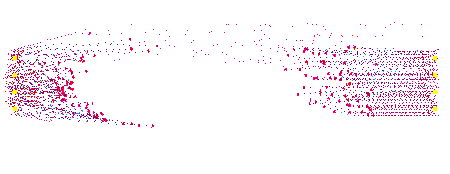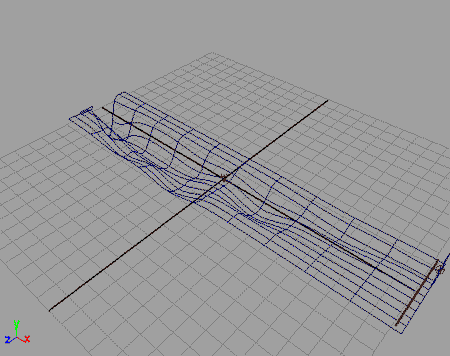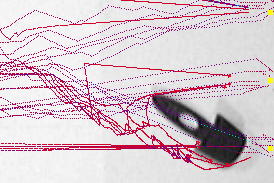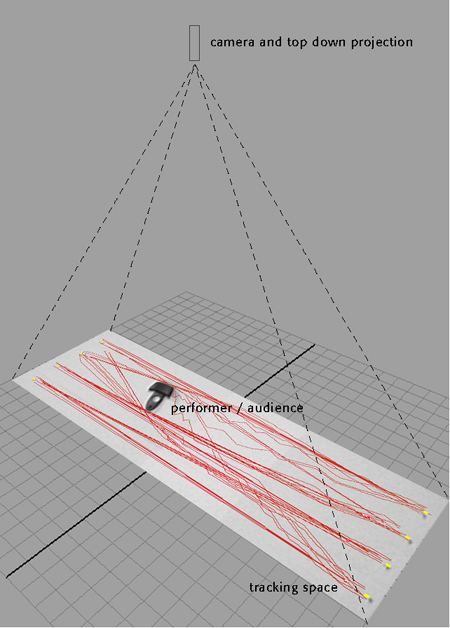Chiron's programme is the basis for the first workshop. The programme defines the behaviour of a set of agents moving from one side of the space to the other. The programme is interfaced with a camera interface allowing the agents to see brightness values in the real world. When the agents come across dark patches (moving or not) they will avoid these.
The agents move in respect to vision: the agents see the goal (attractor) and move towards it. In Crossings the agents see the opposite side of the space from which they are born. Moving across the space they avoid to bump into each other. This creates neat paths negotiating the space. In Crossings this is visualised at a trace. At present this is as a literal trail, in the future this could be as a particle stream emitted from the agent itself.

Behaviour of the agents (no trace and no tracking)

Behaviour of the agents with trace (no tracking)

Behaviour of the agents with trace and tracking
The agents have a certain size and movement quality by which they seek the attractor. This is controlled mostly by their number (e.g. how many they are) but also by the routes and distance they have between them.
The space of the agents will be highly determined by the choice of visualisation. At present we are thinking this as a particle stream affected mutually by the behaviours of the agent and the passerbys.
At present the parameters of the agent space is:
At present the agents leave a trail behind them as they move in space. We are intending to use the agent as a driver for a set of particle streams generating a flow of movement. The particles streams are sited in an environment which holds certain properties such as gravity and perhaps vortexes (these might be better conceived as active attractors perhaps mapped (in some instances) to the presence of the performers).
Following Chiron’s suggestion the particle system will be determined through its flow across an (invisible) surface. The surface is informed by the interface as well as the agents behaviour (speed of movement?). As the movement across the (Mixed Reality) surface slows down the surface deforms creating deep crevices. The surface is continually in a process of deformation thereby controlling the movement of the particles.

The agents operate through their ability to ‘see’ their environment. This ability is defined by the following parameters:
The agents move on a white surface which can be mapped to the input from a camera. In the this case the changes to this white surface (e.g. people moving) will be tracked as boundaries, meaning that the agents will avoid them. (we can set the degree to which the agents will avoid these).
 Detail
of trace: notice the way the traces already form little eddies.
Detail
of trace: notice the way the traces already form little eddies.
The camera interface has the following parameters:
The idea of phase shift and [1] is the change between how entities perform in respect to a set of conditions, moving from one order to the next. This might be a helpful term for us as learning from The Changing Room we will need to introduce the idea of different states into the performance. In The Changing Room this was made through scenographic, choreographic and digital changes (e.g. morphology and colour) to the performance. In Crossings a phase shift could be induced through a change to the way that agents perceive the world, e.g. what do they find attractive and how do they navigate/see the world.
Similarly we could introduce the idea of bifurcations (a splitting of how the system reacts into two simultaneous reactions).

[1] A common example is the gas-liquid phase shift undergone by water. In such a transition, a plot of density versus temperature shows a distinct discontinuity at the critical temperature marking the transition point. Similar behavior can be seen in systems described by ordinary differential flows and discrete mappings. In nonlinear dynamical systems, the transition from self-organizing to chaotic behavior is sometimes referred to as a phase transition (or, more specifically, as an order-disorder transition).
CrossingsFirst workshop: Roehampton University 21/02.05 - new visualisation Second workshop: The Place |